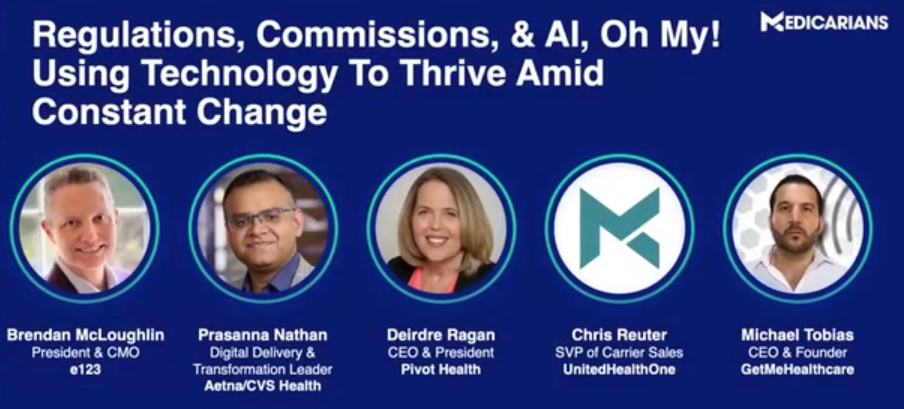How 2026 Will Reshape Open Enrollment for Agents
 e123 Team
·
4 minute read
e123 Team
·
4 minute read
For more than a decade, brokers and agents have adapted to steady changes in the Affordable Care Act (ACA) marketplace. Deadlines shifted, subsidy structures evolved, and new compliance requirements arrived in waves. But January 2026 represents something different — not just incremental adjustments, but a structural shift in how agents will experience open enrollment.
 This post draws from insights shared in Episode 1 of the Insuring Growth Podcast: “Regulatory Changes and Their Impact on Agents,” featuring e123’s Brendan McLoughlin, President at e123 and Dr. Makayla Lavender, Assistant Professor of Economics at UNLV. In that discussion, they unpacked the policy changes reshaping the ACA marketplace and what those shifts mean for agents, carriers, and consumers.
This post draws from insights shared in Episode 1 of the Insuring Growth Podcast: “Regulatory Changes and Their Impact on Agents,” featuring e123’s Brendan McLoughlin, President at e123 and Dr. Makayla Lavender, Assistant Professor of Economics at UNLV. In that discussion, they unpacked the policy changes reshaping the ACA marketplace and what those shifts mean for agents, carriers, and consumers.
You can listen to the full episode below.
These changes — from new CMS rules to the sunset of pandemic-era flexibilities — will redefine what agents do during open enrollment, how they serve clients afterward, and what “success” looks like in this business.
A Shorter Window is Coming
For plan year 2026, the federal open enrollment window remains open through January 15, giving brokers the same cushion they’ve had in recent years to handle late decisions, lingering questions, and last-minute enrollments.
But starting in 2027, that changes. CMS has finalized a rule that shortens the federal enrollment period, ending it December 15 — a return to pre-pandemic timing.
That one-month difference will matter. What was once a manageable extension into January will soon collide with the holidays and year-end planning. For agents, this compression means new strategies for client outreach. Waiting until the last week of the year will lead to an unnecessary rush. To avoid a year-end scramble, proactive engagement in October and November will become essential.
Use this year a practice run — a dress rehearsal — for how open enrollment will be run for 2027 and beyond.
“We’re not just looking at a tighter deadline; we’re looking at a total reset in how brokers plan their year. December 15 becomes the finish line, not the halfway point.”
- Brendan McLoughlin, President, e123, on the Insuring Growth Podcast
The End of “Set It and Forget It”
For years, millions of consumers have relied on auto-enrollment into $0 premium silver plans. Subsidies meant many households didn’t need to take action to renew coverage. That convenience is beginning to shift.
Starting in plan year 2026, CMS will apply new income-verification and auto-reenrollment rules. Most consumers can still be passively reenrolled, but there’s a key change: individuals who don’t update or confirm their information may be automatically placed into a similar plan that carries a minimum $5 monthly premium, even if they previously paid nothing.
That small charge is meant to prompt engagement, but for many consumers it will cause confusion or frustration. The policy also sunsets after the 2026 plan year, meaning its effects could be temporary.
For brokers, the practical takeaway is clear: expect more client outreach and follow-up.
January may bring calls from households wondering why their “free” plan suddenly has a bill. Agents who get ahead of those questions will minimize surprises and preserve trust.
“Imagine being told for years that your plan is free and automatic — and suddenly it isn’t. That’s not a small change for families. Brokers are going to be the ones explaining why.”
- Dr. Makayla Lavender, Assistant Professor of Economics at UNLV, on the Insuring Growth Podcast
More Work, More Questions
As if tighter deadlines and new verification rules weren’t enough, brokers are also taking on more of the load.
While federal funding for ACA navigators — nonprofit and community groups that assist with outreach and enrollment — has fluctuated over the years, the broader trend is clear: fewer community resources mean more consumer questions land on brokers’ desks. As verification becomes more complex and coverage options shift, brokers increasingly serve as the primary guide for households trying to stay covered.
At the same time, clients will face higher costs. With enhanced subsidies set to expire at the end of 2025, many consumers will see premium increases in 2026. Some will downgrade to bronze plans, others will explore off-exchange coverage, and some may choose to go uninsured. Each of those paths comes with uncertainty — and more hands-on guidance from brokers.
“When subsidies shrink, decision-making gets harder. Do I downgrade? Do I leave the exchange? Do I go uninsured? Every one of those paths puts more pressure back on the broker.”
- Brendan McLoughlin, President, e123, on the Insuring Growth Podcast
The Broker’s New Reality
So, what does a broker’s life look like after this enrollment period?
- Busier Decembers: December becomes the do-or-die month for enrollments. Agents who don’t plan outreach early will be scrambling to keep up.
- Chaotic Januaries: Instead of celebrating a successful open enrollment, January will be spent explaining changes, resolving billing surprises, and guiding clients through income verification.
- More Complaints: Consumers accustomed to $0 premium plans will be frustrated by new out-of-pocket costs, even if small. Agents will need to manage expectations carefully.
- Heavier Reliance: With fewer navigators in the system, brokers remain the frontline advisors — for families, for early retirees, and for households losing Medicaid coverage.
In short, open enrollment will demand both speed and stamina. It’s not just about enrolling clients. It’s about preparing them, educating them, and staying engaged after the enrollment period closes.
Strategies to Prepare Now
Forward-thinking agents and agencies can start adjusting today. Some key steps include:
- Front-load client outreach. Don’t wait until December. Begin conversations in October, with reminders in November.
- Educate clients about changes. Prepare simple, plain-language explanations about subsidy changes, re-verification rules, and the shorter enrollment window.
- Use technology to scale communication. Automated reminders, email campaigns, and digital self-service tools can help reduce the burden of one-to-one calls.
- Plan for January service demands. Train staff now to handle billing issues and subsidy questions. Expect more service tickets, not fewer.
- Diversify product options. As some clients look beyond the exchange, brokers should be ready with credible off-exchange alternatives.
Why This Matters for the Industry
The ACA marketplace is at its highest enrollment levels ever, fueled by temporary subsidies and pandemic-era flexibility. Those conditions are ending. The next two years will test whether the marketplace can maintain its size and stability when affordability tightens and processes become more complex.
Agents are at the center of that test. They aren’t just distribution partners; they are the system’s shock absorbers, translating policy into practical choices for households. As 2026 approaches, their role becomes more demanding and more indispensable.



